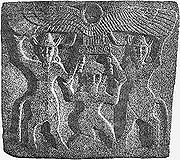
Kapara
Encyclopedia

Aramaeans
The Aramaeans, also Arameans , were a Northwest Semitic semi-nomadic and pastoralist people who originated in what is now modern Syria during the Late Bronze Age and the Iron Age...
kingdom of Bit Bahiani
Bit Bahiani
Bit Bahiani was an independent Aramaean city-state kingdom and an Assyrian province with its capital at Guzana . Bit Bahiani was ruled by King Kapara. After becoming a tributary to Assyria an alliance with Izalla to revolt was formed...
in the 10th or 9th century BC (Albright 1956 estimates ca. 950-875 BC). He built a so-called Bit-hilani
Bit-hilani
A Bit-hilani is an ancient architectural type of palace. It seems to have become popular at the end of the tenth and during the ninth century BCE during the early Iron Age in northern Syria although it may have originated as early as the Bronze Age...
, a monumental palace in Neo-Hittite
Neo-Hittite
The states that are called Neo-Hittite, or more recently Syro-Hittite, were Luwian, Aramaic and Phoenician-speaking political entities of the Iron Age northern Syria and southern Anatolia that arose following the collapse of the Hittite Empire around 1180 BC and lasted until roughly 700 BC...
style discovered by Max von Oppenheim
Max von Oppenheim
Max Freiherr von Oppenheim was a German ancient historian, and archaeologist, "the last of the great amateur archaeological explorers of the Near East."....
in 1911, with a rich decoration of statues and relief orthostats.
In 894 BC, the Assyria
Assyria
Assyria was a Semitic Akkadian kingdom, extant as a nation state from the mid–23rd century BC to 608 BC centred on the Upper Tigris river, in northern Mesopotamia , that came to rule regional empires a number of times through history. It was named for its original capital, the ancient city of Assur...
n king Adad-nirari II
Adad-nirari II
Adad-nirari II is generally considered to be the first King of Assyria in the Neo-Assyrian period. He firmly subjugated the areas previously under only nominal Assyrian vassalage, conquering and deporting troublesome Aramean, Neo-Hittite and Hurrian populations in the north to far-off places...
recorded the site in his archives as a tributary Aramaean city-state. In 808 BC the city and its surrounding area was reduced to a province of the Neo-Assyrian Empire.

